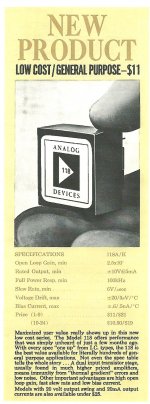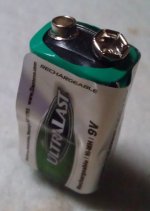The need for loop gain in this particular case had more to do with a fairly low open-loop input impedance for the opamp, not because of the apparent closed loop gain. Scott W., do you recall a module from ancient times that was a sort-of-general-purpose "budget" part? I think the number was the AD118, but of course that number has probably been recycled a few times since --- I couldn't find anything on the web. Maybe it was advertised in Analog Dialogue.
Yes, it's advertised.
Attachments
BTW, that's not a good amp for low current measurements, but in this case the guy had lots of light. For serious astronomical photometry, we made an instrument based on another ADI product from that era, one of their varactor bridge ones. It replaced a Keithley store-bought electrometer.Yes, it's advertised.
Du..uh! I be wrong.Thanks for this Mr. Marsh. It's certainly what's required to replace J5. I'm reminded I have some SPICE models for Siliconix diodes too.
Anyone have or can point to SPICE models for Siliconix constant current dioides?
Anyone have or can point to SPICE models for Siliconix constant current dioides?
Take a look at "diode.lib" from http://www.ece.utah.edu/~ece2280/diode.lib
Dale
Attachments
Last edited:
BTW, that's not a good amp for low current measurements, but in this case the guy had lots of light. For serious astronomical photometry, we made an instrument based on another ADI product from that era, one of their varactor bridge ones. It replaced a Keithley store-bought electrometer.
Still in production, we sold it to a third party who is now making it.
Tecnical Archeology
At first I was puzzled by why they would do a side-by-side comparison of the modular opamp products on the same page as "microcircuit" (i.e., IC) products, since the IC's cost 1/4 to 1/10 as much as the modules. On subsequent pages I saw that the price differential became lower as performance increased, and in a few cases AD didn't even list an IC with comparable performance to some discrete modules.
Of course, that situation had pretty much changed by the early 80's. In the earlier stages of this thread we said there really wasn't much point to creating a discrete design with performance equal, or inferior, to generally-available IC's . . . and then it took a little work to find a set of realistic performance requirements that common IC's could not meet!
Dale
From the Analog Devices "Product Guide" for 1975. Note that the AD118 overall performance is approximately equivalent to a '741. (And by 1975, the '741 was quite outdated even though many engineers didn't figure that out for another decade.). . . a module from ancient times that was a sort-of-general-purpose "budget" part? I think the number was the AD118 . . .
At first I was puzzled by why they would do a side-by-side comparison of the modular opamp products on the same page as "microcircuit" (i.e., IC) products, since the IC's cost 1/4 to 1/10 as much as the modules. On subsequent pages I saw that the price differential became lower as performance increased, and in a few cases AD didn't even list an IC with comparable performance to some discrete modules.
Of course, that situation had pretty much changed by the early 80's. In the earlier stages of this thread we said there really wasn't much point to creating a discrete design with performance equal, or inferior, to generally-available IC's . . . and then it took a little work to find a set of realistic performance requirements that common IC's could not meet!
Dale
Attachments
Thanks for this & the attached file, DaleTake a look at "diode.lib" from http://www.ece.utah.edu/~ece2280/diode.lib
____________
Scott, is there a SPICE model of AD797 which allows 'accurate' modelling of output Z & stability in a circuit like Fig 39 of the datasheet?
Thanks for this & the attached file, Dale
____________
Scott, is there a SPICE model of AD797 which allows 'accurate' modelling of output Z & stability in a circuit like Fig 39 of the datasheet?
No.
From the Analog Devices "Product Guide" for 1975. Note that the AD118 overall performance is approximately equivalent to a '741. (And by 1975, the '741 was quite outdated even though many engineers didn't figure that out for another decade.)
Dale
AD301AL my first project. I found a built-in offset and drift source that survived all previous layouts.
Folks forget about macro-models being anything more than gross approximations. We have again reached an impass on providing full encripted models via over-the-web simulation. The technology is there, but it will remain for major customers with NDA's only.
I've never understood the reasoning about not providing transistor level models - isn't anything you really care about is protected by patents, can't transistor level circuit topology can be reverse engineered by any interested competition from the die?
http://www.google.com/#hl=en&tbo=d&...8b13d38ba68b9&bpcl=39967673&biw=1920&bih=1069
presumably the real secret sauce and barrier to competition is the $Billion fab lines, processing expertise
but even with macromodeling – it is very annoying when the manufacturer's haven't even taken care to exploit their own published macromodeling to a merely competent extent, not even getting them to a coarse eyeball match to datasheet curves in parameters where the macromodels could work
disclosure: I have an open complaint about the AD8067 model on Analog's support forum
http://www.google.com/#hl=en&tbo=d&...8b13d38ba68b9&bpcl=39967673&biw=1920&bih=1069
presumably the real secret sauce and barrier to competition is the $Billion fab lines, processing expertise
but even with macromodeling – it is very annoying when the manufacturer's haven't even taken care to exploit their own published macromodeling to a merely competent extent, not even getting them to a coarse eyeball match to datasheet curves in parameters where the macromodels could work
disclosure: I have an open complaint about the AD8067 model on Analog's support forum
Last edited:
This has been a real Three Stooges weekend. On Saturday I took a couple 9V NI-MH batteries out of one of my test bench pre-amps and put them in my pocket and walked over to where I keep the charger. As these things go the batteries did a face to face meeting and by the time I got to my office I said, “what’s burning?” My first thought was that if the sprinklers get triggered everything is toast. Then I saw the smoke coming out of my pocket and pulled them out just before meltdown.
Then I wasted and embarrassing amount of time finding a jagged solder ball that was lodged under an electrolytic cap that had rubbed through the plastic coating shorting a node intermittently to V-.
All ended well I hope to have a summary up soon. A little taming of the BW and everything looks good. I’ll poke through the breadboard and and note exactly what is there (the differences are minor).
Then I wasted and embarrassing amount of time finding a jagged solder ball that was lodged under an electrolytic cap that had rubbed through the plastic coating shorting a node intermittently to V-.
All ended well I hope to have a summary up soon. A little taming of the BW and everything looks good. I’ll poke through the breadboard and and note exactly what is there (the differences are minor).
Attachments
JCX -- I can understand not having details of an IC or OPAmp. But a single transistor? We cant even get that right a lot of the time. Maybe we can learn to measure all the parameters important to audio ourselves and publish them. Thx-RNMarsh
Last edited:
The slew rate was at least a factor of 12 more than the 741. I don't recall what the noise was like.From the Analog Devices "Product Guide" for 1975. Note that the AD118 overall performance is approximately equivalent to a '741.
Dale
jcx - I can certainly get your problem to the top of the stack. The full encrypted models include all the details of the process characterization which is the real problem. Models based on more use of "real" transistors are a lot of work which needs experienced engineering input.
It's also been forensic electronics for me the last few days, working on manifold problems with a digital touchscreen watch not of my design. But after writing up a summary and transmitting it this morning, it was off to Disney Hall to hear Mozart, Hindemith, and Dvorak. Good music, great band as usual, wonderful hall, but frankly, a rather uninspired conducting job from Zubin Mehta.This has been a real Three Stooges weekend. On Saturday I took a couple 9V NI-MH batteries out of one of my test bench pre-amps and put them in my pocket and walked over to where I keep the charger. As these things go the batteries did a face to face meeting and by the time I got to my office I said, “what’s burning?” My first thought was that if the sprinklers get triggered everything is toast. Then I saw the smoke coming out of my pocket and pulled them out just before meltdown.
Then I wasted and embarrassing amount of time finding a jagged solder ball that was lodged under an electrolytic cap that had rubbed through the plastic coating shorting a node intermittently to V-.
All ended well I hope to have a summary up soon. A little taming of the BW and everything looks good. I’ll poke through the breadboard and and note exactly what is there (the differences are minor).
jcx - I can certainly get your problem to the top of the stack.
thanx, but not necessary - moslty a complaint - not a problem for me - I've already edited my copy to add the 46 dB missing DC gain, reduce the over spec Vos, I can put my own RL in series with the output to continue the datasheet plot's output Z rise beyond the gain intercept...
Scott, is there even a simplified SPICE model for AD797?I've already edited my copy to add the 46 dB missing DC gain, reduce the over spec Vos, I can put my own RL in series with the output to continue the datasheet plot's output Z rise beyond the gain intercept...
Even if it doens't do 'accurate' Zo and stability with load 😡
Scott, is there even a simplified SPICE model for AD797?
Even if it doens't do 'accurate' Zo and stability with load 😡
Gee Richard they are right there on the web site. This is the basis for them, http://www.analog.com/static/imported-files/application_notes/AN-138.pdf.
If you're very clever you can spot part of the problem in the credits. I don't think any other choices are much better.
jcx - The AD8067 post dates the initial onslaught of macro-modling, now, say no more.
In that 1990 article, it was acknowledged that sim work was beoming the way for engineers to evaluate and design circuits. So, by now the marketing dept must surely know that to sell more IC's (OPA, transistors et al) they need to supply accurate SPICE models. 'Cause it will sell parts faster/more. Though it is a chore to assign to some poor sole, its a win-win to do so. -RNM
- Home
- Source & Line
- Analog Line Level
- Discrete Opamp Open Design

